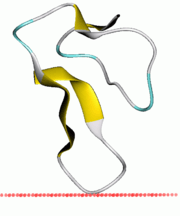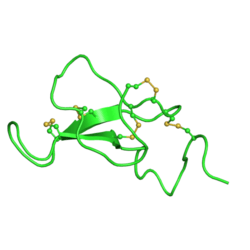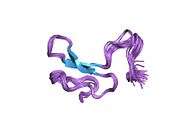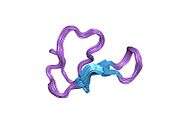Agouti-related peptide
Agouti-related protein (AgRP), also called agouti-related peptide, is a neuropeptide produced in the brain by the AgRP/NPY neuron. It is synthesized only in neuropeptide Y (NPY)-containing cell bodies located in the ventromedial part of the arcuate nucleus in the hypothalamus.[5] AgRP is co-expressed with NPY and acts to increase appetite and decrease metabolism and energy expenditure. It is one of the most potent and long-lasting of appetite stimulators. In humans, the agouti-related peptide is encoded by the AGRP gene.[6][7]
Structure
AgRP is a paracrine signalling molecule made up of 112 amino acids (the gene product of 132 amino acids is processed by removal of the N-terminal 20-residue signal peptide domain). It was independently identified by two teams in 1997 based on its sequence similarity with agouti signalling peptide (ASIP), a protein synthesised in the skin that controls coat colour.[6][7] AgRP is approximately 25% identical to ASIP. The murine homologue of AgRP consists of 111 amino acids (precursor is 131 amino acids) and shares 81% amino acid identity with the human protein. Biochemical studies indicate AgRP to be very stable to thermal denaturation and acid degradation. Its secondary structure consists mainly of random coils and β-sheets[8] that fold into an inhibitor cystine knot motif.[9] AGRP maps to human chromosome 16q22 and Agrp to mouse chromosome 8D1-D2.
Function
Agouti-related protein is expressed primarily in the adrenal gland, subthalamic nucleus, and hypothalamus, with lower levels of expression in the testis, kidneys, and lungs. The appetite-stimulating effects of AgRP are inhibited by the hormone leptin and activated by the hormone ghrelin. Adipocytes secrete leptin in response to food intake. This hormone acts in the arcuate nucleus and inhibits the AgRP/NPY neuron from releasing orexigenic peptides.[10] Ghrelin has receptors on NPY/AgRP neurons that stimulate the secretion of NPY and AgRP to increase appetite. AgRP is stored in intracellular secretory granules and is secreted via a regulated pathway.[11] The transcriptional and secretory action of AgRP is regulated by inflammatory signals.[12] Levels of AgRP are increased during periods of fasting. It has been found that AgRP stimulates the hypothalamic-pituitary-adrenocortical axis to release ACTH, cortisol and prolactin. It also enhances the ACTH response to IL-1-beta, suggesting it may play a role in the modulation of neuroendocrine response to inflammation.[13] Conversely, AgRP-secreting neurons inhibit the release of TRH from the PVN, which may contribute to conservation of energy in starvation.[14] This pathway is part of a feedback loop, since TRH-secreting neurons from PVN stimulate AgRP neurons.[15]
Mechanism
AGRP has been demonstrated to be an inverse agonist of melanocortin receptors, to be specific MC3-R and MC4-R. The melanocortin receptors, MC3-R and MC4-R, are directly linked to metabolism and body weight control. These receptors are activated by the peptide hormone α-MSH (melanocyte-stimulating hormone) and antagonized by the agouti-related protein.[16] Whereas α-MSH acts broadly on most members of the MCR family (with the exception of MC2-R), AGRP is highly specific for only MC3-R and MC4-R. This inverse agonism not only antagonizes the action of melanocortin agonists such as α-MSH but also further decreases the cAMP produced by the affected cells. The exact mechanism by which AgRP inhibits melanocortin-receptor signalling is not completely clear. It has been suggested that Agouti-related protein binds MSH receptors and acts as a competitive antagonist of ligand binding.[17] Studies of Agouti protein in B16 melanoma cells supported this logic. The expression of AgRP in the adrenal gland is regulated by glucocorticoids. The protein blocks α-MSH-induced secretion of corticosterone.[18]
History
Orthologs of AgRP, ASIP, MCIR, and MC4R have been found in mammalian, teleost fish, and avian genomes. This suggests that the agouti-melanocortin system evolved by gene duplication from individual ligand and receptor genes in the last 500 million years.[16]
Role in obesity
AgRP induces obesity by chronic antagonism of the MC4-R.[19] Overexpression of AgRP in transgenic mice (or intracerebroventricular injection) causes hyperphagia and obesity,[20] whilst AgRP plasma levels have been found to be elevated in obese human males.[21] Understanding the role AgRP plays in weight gain may assist in developing pharmaceutical models for treating obesity. AgRP mRNA levels have been found to be down regulated following an acute stressful event. Studies suggest that systems involved in the regulation of stress response and of energy balance are highly integrated. Loss or gain of AgRP function may result in inadequate adaptive behavioural responses to environmental events, such as stress, and have potential to contribute to the development of eating disorders. It has been shown that polymorphisms in the AgRP gene have been linked with anorexia nervosa[22] as well as obesity. Some studies suggest that inadequate signalling of AgRP during stress may result in binge eating. Starvation-induced hypothalamic autophagy generates free fatty acids, which in turn regulate neuronal AgRP levels.[23]
| Agouti protein | |||||||||
|---|---|---|---|---|---|---|---|---|---|
 | |||||||||
| Identifiers | |||||||||
| Symbol | Agouti | ||||||||
| Pfam | PF05039 | ||||||||
| Pfam clan | CL0083 | ||||||||
| InterPro | IPR007733 | ||||||||
| PROSITE | PDOC60024 | ||||||||
| SCOPe | 1hyk / SUPFAM | ||||||||
| OPM superfamily | 112 | ||||||||
| OPM protein | 1mr0 | ||||||||
| |||||||||
Human proteins containing this domain
AGRP; ASIP
See also
- Proopiomelanocortin
- Agouti (gene)
References
- GRCh38: Ensembl release 89: ENSG00000159723 - Ensembl, May 2017
- GRCm38: Ensembl release 89: ENSMUSG00000005705 - Ensembl, May 2017
- "Human PubMed Reference:". National Center for Biotechnology Information, U.S. National Library of Medicine.
- "Mouse PubMed Reference:". National Center for Biotechnology Information, U.S. National Library of Medicine.
- Bäckberg M, Madjid N, Ogren SO, Meister B (Jun 2004). "Down-regulated expression of agouti-related protein (AGRP) mRNA in the hypothalamic arcuate nucleus of hyperphagic and obese tub/tub mice". Brain Research. Molecular Brain Research. 125 (1–2): 129–39. doi:10.1016/j.molbrainres.2004.03.012. PMID 15193430.
- Shutter JR, Graham M, Kinsey AC, Scully S, Lüthy R, Stark KL (Mar 1997). "Hypothalamic expression of ART, a novel gene related to agouti, is up-regulated in obese and diabetic mutant mice". Genes & Development. 11 (5): 593–602. doi:10.1101/gad.11.5.593. PMID 9119224.
- Ollmann MM, Wilson BD, Yang YK, Kerns JA, Chen Y, Gantz I, Barsh GS (Oct 1997). "Antagonism of central melanocortin receptors in vitro and in vivo by agouti-related protein". Science. 278 (5335): 135–8. doi:10.1126/science.278.5335.135. PMID 9311920.
- Rosenfeld RD, Zeni L, Welcher AA, Narhi LO, Hale C, Marasco J, Delaney J, Gleason T, Philo JS, Katta V, Hui J, Baumgartner J, Graham M, Stark KL, Karbon W (Nov 1998). "Biochemical, biophysical, and pharmacological characterization of bacterially expressed human agouti-related protein". Biochemistry. 37 (46): 16041–52. doi:10.1021/bi981027m. PMID 9819197.
- Jackson PJ, McNulty JC, Yang YK, Thompson DA, Chai B, Gantz I, Barsh GS, Millhauser GL (Jun 2002). "Design, pharmacology, and NMR structure of a minimized cystine knot with agouti-related protein activity". Biochemistry. 41 (24): 7565–72. doi:10.1021/bi012000x. PMID 12056887.
- Enriori PJ, Evans AE, Sinnayah P, Jobst EE, Tonelli-Lemos L, Billes SK, Glavas MM, Grayson BE, Perello M, Nillni EA, Grove KL, Cowley MA (Mar 2007). "Diet-induced obesity causes severe but reversible leptin resistance in arcuate melanocortin neurons". Cell Metabolism. 5 (3): 181–94. doi:10.1016/j.cmet.2007.02.004. PMID 17339026.
- Creemers JW, Pritchard LE, Gyte A, Le Rouzic P, Meulemans S, Wardlaw SL, Zhu X, Steiner DF, Davies N, Armstrong D, Lawrence CB, Luckman SM, Schmitz CA, Davies RA, Brennand JC, White A (Apr 2006). "Agouti-related protein is posttranslationally cleaved by proprotein convertase 1 to generate agouti-related protein (AGRP)83-132: interaction between AGRP83-132 and melanocortin receptors cannot be influenced by syndecan-3". Endocrinology. 147 (4): 1621–31. doi:10.1210/en.2005-1373. PMID 16384863.
- Scarlett JM, Zhu X, Enriori PJ, Bowe DD, Batra AK, Levasseur PR, Grant WF, Meguid MM, Cowley MA, Marks DL (Oct 2008). "Regulation of agouti-related protein messenger ribonucleic acid transcription and peptide secretion by acute and chronic inflammation". Endocrinology. 149 (10): 4837–45. doi:10.1210/en.2007-1680. PMC 2582916. PMID 18583425.
- Xiao E, Xia-Zhang L, Vulliémoz NR, Ferin M, Wardlaw SL (May 2003). "Agouti-related protein stimulates the hypothalamic-pituitary-adrenal (HPA) axis and enhances the HPA response to interleukin-1 in the primate". Endocrinology. 144 (5): 1736–41. doi:10.1210/en.2002-220013. PMID 12697678.
- Nillni EA (April 2010). "Regulation of the hypothalamic thyrotropin releasing hormone (TRH) neuron by neuronal and peripheral inputs". Frontiers in Neuroendocrinology. 31 (2): 134–56. doi:10.1016/j.yfrne.2010.01.001. PMC 2849853. PMID 20074584.
- Krashes MJ, Shah BP, Madara JC, Olson DP, Strochlic DE, Garfield AS, Vong L, Pei H, Watabe-Uchida M, Uchida N, Liberles SD, Lowell BB (March 2014). "An excitatory paraventricular nucleus to AgRP neuron circuit that drives hunger". Nature. 507 (7491): 238–42. doi:10.1038/nature12956. PMC 3955843. PMID 24487620.
- Jackson PJ, Douglas NR, Chai B, Binkley J, Sidow A, Barsh GS, Millhauser GL (Dec 2006). "Structural and molecular evolutionary analysis of Agouti and Agouti-related proteins". Chemistry & Biology. 13 (12): 1297–305. doi:10.1016/j.chembiol.2006.10.006. PMC 2907901. PMID 17185225.
- Ollmann MM, Lamoreux ML, Wilson BD, Barsh GS (Feb 1998). "Interaction of Agouti protein with the melanocortin 1 receptor in vitro and in vivo". Genes & Development. 12 (3): 316–30. doi:10.1101/gad.12.3.316. PMC 316484. PMID 9450927.
- Dhillo WS, Small CJ, Gardiner JV, Bewick GA, Whitworth EJ, Jethwa PH, Seal LJ, Ghatei MA, Hinson JP, Bloom SR (Jan 2003). "Agouti-related protein has an inhibitory paracrine role in the rat adrenal gland". Biochemical and Biophysical Research Communications. 301 (1): 102–7. doi:10.1016/S0006-291X(02)02991-1. PMID 12535647.
- Huszar D, Lynch CA, Fairchild-Huntress V, Dunmore JH, Fang Q, Berkemeier LR, Gu W, Kesterson RA, Boston BA, Cone RD, Smith FJ, Campfield LA, Burn P, Lee F (Jan 1997). "Targeted disruption of the melanocortin-4 receptor results in obesity in mice". Cell. 88 (1): 131–41. doi:10.1016/S0092-8674(00)81865-6. PMID 9019399.
- Graham M, Shutter JR, Sarmiento U, Sarosi I, Stark KL (Nov 1997). "Overexpression of Agrt leads to obesity in transgenic mice". Nature Genetics. 17 (3): 273–4. doi:10.1038/ng1197-273. PMID 9354787.
- Katsuki A, Sumida Y, Gabazza EC, Murashima S, Tanaka T, Furuta M, Araki-Sasaki R, Hori Y, Nakatani K, Yano Y, Adachi Y (May 2001). "Plasma levels of agouti-related protein are increased in obese men". The Journal of Clinical Endocrinology and Metabolism. 86 (5): 1921–4. doi:10.1210/jc.86.5.1921. PMID 11344185.
- Vink T, Hinney A, van Elburg AA, van Goozen SH, Sandkuijl LA, Sinke RJ, Herpertz-Dahlmann BM, Hebebrand J, Remschmidt H, van Engeland H, Adan RA (May 2001). "Association between an agouti-related protein gene polymorphism and anorexia nervosa". Molecular Psychiatry. 6 (3): 325–8. doi:10.1038/sj.mp.4000854. PMID 11326303.
- Kaushik S, Rodriguez-Navarro JA, Arias E, Kiffin R, Sahu S, Schwartz GJ, Cuervo AM, Singh R (2011). "Autophagy in hypothalamic AgRP neurons regulates food intake and energy balance". Cell Metabolism. 14 (2): 173–83. doi:10.1016/j.cmet.2011.06.008. PMC 3148494. PMID 21803288.
Further reading
- Dhillo WS, Gardiner JV, Castle L, Bewick GA, Smith KL, Meeran K, Todd JF, Ghatei MA, Bloom SR (Dec 2005). "Agouti related protein (AgRP) is upregulated in Cushing's syndrome" (PDF). Experimental and Clinical Endocrinology & Diabetes. 113 (10): 602–6. doi:10.1055/s-2005-872895. hdl:10044/1/270. PMID 16320160.
- Dinulescu DM, Cone RD (Mar 2000). "Agouti and agouti-related protein: analogies and contrasts". The Journal of Biological Chemistry. 275 (10): 6695–8. doi:10.1074/jbc.275.10.6695. PMID 10702221.
- Scarlett JM, Zhu X, Enriori PJ, Bowe DD, Batra AK, Levasseur PR, Grant WF, Meguid MM, Cowley MA, Marks DL (Oct 2008). "Regulation of agouti-related protein messenger ribonucleic acid transcription and peptide secretion by acute and chronic inflammation". Endocrinology. 149 (10): 4837–45. doi:10.1210/en.2007-1680. PMC 2582916. PMID 18583425.
- Creemers JW, Pritchard LE, Gyte A, Le Rouzic P, Meulemans S, Wardlaw SL, Zhu X, Steiner DF, Davies N, Armstrong D, Lawrence CB, Luckman SM, Schmitz CA, Davies RA, Brennand JC, White A (Apr 2006). "Agouti-related protein is posttranslationally cleaved by proprotein convertase 1 to generate agouti-related protein (AGRP)83-132: interaction between AGRP83-132 and melanocortin receptors cannot be influenced by syndecan-3". Endocrinology. 147 (4): 1621–31. doi:10.1210/en.2005-1373. PMID 16384863.
- Katsuki A, Sumida Y, Gabazza EC, Murashima S, Tanaka T, Furuta M, Araki-Sasaki R, Hori Y, Nakatani K, Yano Y, Adachi Y (May 2001). "Plasma levels of agouti-related protein are increased in obese men". The Journal of Clinical Endocrinology and Metabolism. 86 (5): 1921–4. doi:10.1210/jc.86.5.1921. PMID 11344185.
- Kas MJ, Bruijnzeel AW, Haanstra JR, Wiegant VM, Adan RA (Aug 2005). "Differential regulation of agouti-related protein and neuropeptide Y in hypothalamic neurons following a stressful event". Journal of Molecular Endocrinology. 35 (1): 159–64. doi:10.1677/jme.1.01819. PMID 16087729.
- Jackson PJ, Yu B, Hunrichs B, Thompson DA, Chai B, Gantz I, Millhauser GL (Oct 2005). "Chimeras of the agouti-related protein: insights into agonist and antagonist selectivity of melanocortin receptors". Peptides. 26 (10): 1978–87. doi:10.1016/j.peptides.2004.12.036. PMID 16009463.
- Bäckberg M, Madjid N, Ogren SO, Meister B (Jun 2004). "Down-regulated expression of agouti-related protein (AGRP) mRNA in the hypothalamic arcuate nucleus of hyperphagic and obese tub/tub mice". Brain Research. Molecular Brain Research. 125 (1–2): 129–39. doi:10.1016/j.molbrainres.2004.03.012. PMID 15193430.
External links
- agouti-related+protein at the US National Library of Medicine Medical Subject Headings (MeSH)
- Agouti domain in PROSITE
- Human AGRP genome location and AGRP gene details page in the UCSC Genome Browser.






